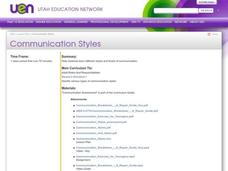Curated OER
Taxes
Young scholars use the internet to examine the various types of taxes. Using this information, they develop a chart comparing and contrasting the types and determinations of how much tax needs to be paid. They share their charts with...
Curated OER
Outreach in the Aftermath
Students investigate types of aid needed to help Turkey recover and rebuild in the wake of a devastating earthquake on August 17, 1999. They create a plan for a fundraiser or project that they can do to offer assistance to victims of...
Curated OER
Timely Technologies
Second graders explain how society influences the type of technology developed. In this science lesson, 2nd graders research about a topic they chose from the given list. They develop a creative presentation about it such as a play,...
Curated OER
Art and Propaganda
High schoolers examine the types of propaganda used throughout World War II. In groups, they view examples of different posters and artwork used to identify the human emotions the government was trying to appeal through. They develop...
Curated OER
Sliders - Static and Kinetic Friction
Students work in groups to conduct experiments the demonstrate the differences between static and kinetic friction. They consider how friction affects us in our everyday lives, determine the effects of weight on friction and complete a...
Curated OER
White Collar Crime
High schoolers discuss difference between crimes of deceit versus crimes of violence, define white-collar crime, and examine far reach of white collar crime laws. Students then analyze what differences exist between rationales for...
Curated OER
The Living Corn Necklace
Fifth graders generate two types of corn seeds, Dent corn and Indian corn to compare the similarities and differences of each of the seedlings. The preferred seedlings are determined through observations made by Students.
Curated OER
Fossils Footprints Across Time
Students examine fossils to understand how they are formed and how they give information about geological history. In this fossil activity, students research and write about fossils and make models of different fossil types.The PDF...
Curated OER
Sound Observations
Learners explore sound waves by conducting an experiment in class. In this sound frequency lesson, students utilize a tuning fork in class and identify which objects in class create different sound pitches on the fork. Learners conduct...
Curated OER
Winter and Summer Storms Scenarios
Fourth graders discover the patterns that create summer and winter storms. Working in groups, they create model storms for summer and winter. Students discuss the reasons why summer storms and winter storms are different and explain...
Curated OER
Bootleg Bytes
Learners conduct background research to explore the positions of different groups involved in the digital piracy debate, then participate in a fishbowl discussion that seeks to find a consensus on the issue.
Curated OER
50th Anniversary of Brown v. Board of Education
Young scholars examine a poster of Brown v. Board of Education and discuss what the important details are. They read the story behind the poster and court case. They role play different sections of the case such as the court case or...
Curated OER
The Rainforest
Students discuss ways in which the rainforest can be preserved. In groups, they locate a major rainforest and list its benefits to the environment. They develop possible solutions as a class to help governments, industries and...
Curated OER
Getting our Paws into the Cause
Twelfth graders examine local, state, and/or national animal welfare organization. In this Social Studies lesson, 12th graders research their identified organization. Students develop a planned intervention...
Curated OER
Weather Walks
Students study weather by taking walks in various types weather conditions.
Curated OER
Air Quality and Transportation
Second graders observe car pooling patterns and the important role car pools play in reducing air pollution. They explain how they get to school and graph the types of transportation that is used. Students make a list of the different...
Curated OER
Religions
Students write a report on Roman religions. In this religion lesson, students make a web including all the religions they know about, discuss what religion means and predict what kind of religions existed in Ancient Rome. ...
Curated OER
Chemical Leavening Agents
Discuss leavening agents and baked goods. Describe the purpose of leavening agents in baked goods List the four major leavening agents Explain why baking soda is used with an acid in baked goods Identify the types of doughs and batters...
Curated OER
Rhytym in Interior Design
Students demonstrate the use of rhythm in interior design. They create a sample page showing five different elements of rhythm as it is used in visual art. These elements include: repetition, gradation, transition,
opposition, and...
Curated OER
Architecture Scavenger Hunt
Ninth graders explain basic terms and identify illustrations of architectural features and styles. They locate and identify the different architectural styles and terminology that exists in the community and neighborhoods that they live...
Curated OER
Communication Styles
Students study different styles and levels of communication. They define the levels of communication and assess personal communication styles. They view a video and explore a webquest examining the topic "Strengthening Family and Self".
Curated OER
Dating - What is Love?
Students explore their feeling on love. They write down their feelings and talk about love and infatuation and what the differences are. Students study the Ladder of Love and write a love poem of their own. They identify the various...
Curated OER
Making Sense Of A Round World On A Flat Surface
Students engage in a lesson that is concerned with the development of geography skills. They take part in a number of activities that center around finding and traveling to different locations. The lesson has resource links that can be...
Curated OER
Dia de la Independencia
Students learn about Mexican Independence Day. In this Hispanic Heritage lesson plan, students learn about holidays in Hispanic countries specifically looking at their days of independence. Students read information about...

























